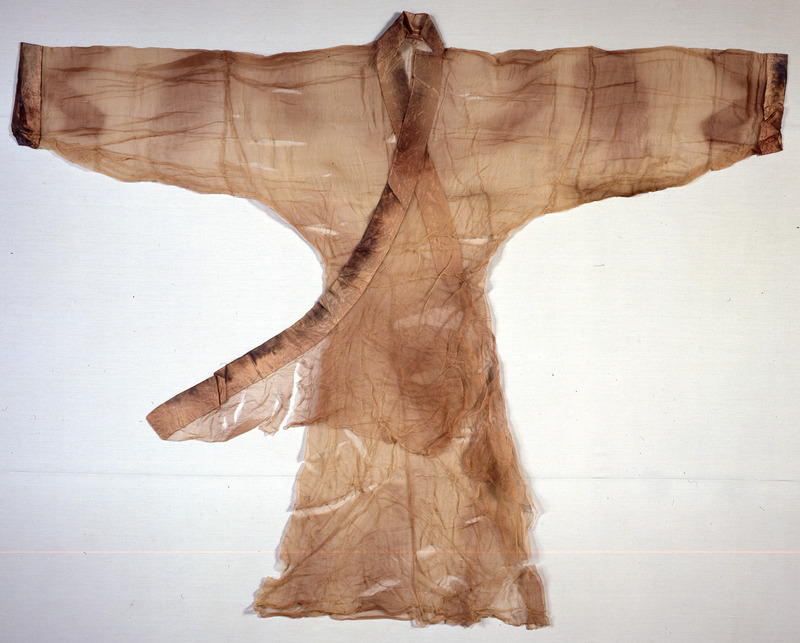Plain Gauze Gown

Plain Gauze Gown
Western Han Dynasty (206 BC – 25 AD)
Unearthed from Han Tomb No.1 at Mawangdui, Changsha City, Hunan Province, China
Dimensions: Length of Clothes: 128cm, Width between Sleeves: 190cm; Area of t the Clothes: 2.6m2; Weight: 49g
The gown, consisting of a jacket and a straight skirt, has a crossed collar, a flap extending diagonally from left to right and is hemmed with brocade with piled circles in a geometric pattern.
The gown, first-level cultural relics, is the earliest, most well-preserved, most exquisite and thinnest dress in the world. With the material areas reaching about 2.6 m2, the gauze weighs only 49g and even only 25g after removing the sleeve-openings and collar and can be folded into a matchbox. This piece of treasure, “thin as a cicada wing” and “as light as smoke”, represents the highest level of early Han in sericiculture, silk reeling and fabric manufacture.
There’s a wide spectrum of opinions on the function of this gown. The historical record says this translucent gown was coated on the bright silk floss clothes to add a sense of hazy beauty; some experts hold that it is a funeral object; while some others believed it is a piece of sexy underwear.
深入探索
About Shenyi (Long Dress)
From the Zhou Dynasty (11th century BC—256BC) to the Han Dynasty, the dominant Chinese dress was the shenyi (means long dress). Ancient Chinese wore yi for the upper body and shang for the lower body. For convenience, yi and shang later were sewn together to become the pao—a lined and padded robe or long dress. In time, yi and shang were no longer cut and divided, but were combined into a complete whole called danyi (gown without linning). But pao and danyi can be divided into two types according to the shape of the front: one is the L-shaped front that starts from the collar and extends diagonally to the armpit; the other is the straight front that begins at the collar but extends straight downward. Of the twelve silk gowns unearthed from Han Tomb No.1 at Mawangdui, nine used the L-shaped front; the remaining three gauze gown had printed and painted designs and used the straight front. The wooden figurines and the images in the paintings also offered abundant materials to prove this point.
Among the three danyi (thin gown without lining) unearthed from Han Tomb No.1, the most exquisite is the susha danyi (plain gauze gown). This gown is as thin as a cicada’s wings and as light as a floating cloud, astounding even modern silk experts with its delicacy. It is the earliest and thinnest textile treasure extant in China, and it highlights the superb skills of weavers in the early Han dynasty. Through the modern analytical methods of X-ray diffraction and measuring amino acid content, all the silk fabrics unearthed from the tombs at Mawandui were determined to have come from silk-worm fibers (domesticated silkworms). The fiber number of the warp and weft silk of the silk gauze gown in plain color is between 10.2 to 11.3 deniers, very close to the finest fiber number attained in modern reeling. That such a fine fiber number could be attained with simple reeling tools demonstrated the advanced level and reeling techniques in Changsha region.




